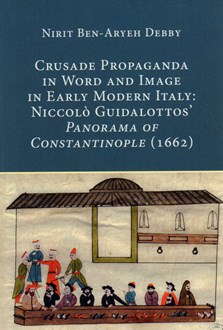Crusade propaganda in word and image in early modern Italy : Niccolò Guidalottos' panorama of Constantinople (1662) / Nirit Ben-Aryeh Debby.
Yer Numarası
A.IX/2291
ISBN
9780772721839 (paperback)
9780772721846 (pdf)
9780772721846 (pdf)
Dil Kodu
İngilizce
Yazar
Yayın Bilgisi
Toronto : Centre for Reformation and Renaissance Studies, 2016.
Dizi
Essays and studies ; 38
Genel Not
İndeks s. 155-163.
Bibliyografi, vb. Notu
Bibliyografya s. 141-154.
Özet, vb.
“The focus of the book is a vast (6.5 meters x 3.5 meters) and recently revealed 17th century panorama of Constantinople that is an exceptional drawing of the city. The Panorama is an elaborate piece of anti-Ottoman propaganda designed by the Franciscan friar Niccolò Guidalotto da Mondavio. It was first found in the Chigi archive in Rome and is currently displayed in the Tel Aviv Museum of Art. Guidalotto also prepared a large manuscript, held in the Vatican Library, which details the Panorama's meaning and the motivation behind its creation. It depicts Istanbul as seen from across the Golden Horn in Galata, throwing new light on both the city and the relationships between the rival Venetian Republic and the Ottoman Empire. It also trumpets the unalloyed Christian zeal of Niccolò Guidalotto and serves as a fascinating example of visual crusade propaganda against the Ottomans in the 17th century. The current book examines the artistic features and the historical significance of this unique panorama. It reveals new information about its creator and contributes to the current scholarly discussion on crusade propaganda in art and literature from the 17th century. The Panorama is a source of cultural clash, a confrontation point between east and west, and it is a virtually unknown and unexplored sample of visual propaganda that was only recently discovered. The fact that the Panorama tells us that the Venetians were still calling for a Crusade at this late date is of prime historical importance in the study of European attitudes in the mid-seventeenth century. The Panorama's artistic features are a central focus of this book, which joins art history and history, viewing the Panorama as an interdisciplinary creation that incorporates a unique visual language worthy of the attention of art historians. The book joins word and image, i.e., it explains the meaning and significance of the complex visual imagery of the Panorama via the accompanying manuscript.“-- Provided by publisher.
Konu
Guidalotto, Niccolò__Panorama.
Propaganda, İtalyan__Tarih__17. yüzyıl.
Propaganda, sanatta.
Propaganda, edebiyatta.
Haçlı seferleri__Sanat.
İstanbul (Türkiye)__Sanat.
İtalya__Dış ilişkiler__Türkiye.
Türkiye__Dış ilişkiler__İtalya.
Venedik (İtalya)__Tarih__1508-1797.
Türkiye__Tarih__Osmanlı İmparatorluğu, 1288-1918.
Propaganda, İtalyan__Tarih__17. yüzyıl.
Propaganda, sanatta.
Propaganda, edebiyatta.
Haçlı seferleri__Sanat.
İstanbul (Türkiye)__Sanat.
İtalya__Dış ilişkiler__Türkiye.
Türkiye__Dış ilişkiler__İtalya.
Venedik (İtalya)__Tarih__1508-1797.
Türkiye__Tarih__Osmanlı İmparatorluğu, 1288-1918.

 English
English

